Taking Jesus to the Streets of San Francisco and Across the Golden Gate Bridge
En Route to the First Eucharistic Congress Since World War II
U.S. Catholic bishops began talking about the need for Eucharistic Revival in 2019 soon after a Pew study showed that a dismayingly high percentage of Catholics either had never learned or don't believe this core belief of the Catholic Faith—that during the Mass the bread and wine consecrated by the priest become the Body and Blood of Jesus Christ.
A National Eucharistic Pilgrimage started from four points of the compass on Pentecost Sunday, May 19, and the processions over the four routes will converge at the National Eucharistic Congress in Indianapolis that will start July 17. Why Indianapolis? It's centrally located. Catholic News Agency tells us that "Half of America lives within a day's drive" of the city. Who knew? Okay, probably many others knew. But I didn’t.
The National Eucharistic Pilgrimage, which is a long-planned massive public witness to the Catholic Church's belief in Christ in the Eucharist, is one outcome of the bishops' deliberations during a three-year Eucharistic revival campaign that started June 19, 2022. The bishops (and many other Catholics) are hoping (and praying) to start a fire that will deepen Catholics' faith in what the Church calls the Real Presence of Christ, renew that faith where it has gone dim, but also spark new faith where none existed before.
Some Terminology for the Unfamiliar (Scroll Down to Skip)
Some definitions might be helpful here.. The Catholic term for that miraculous transformation that occurs at every Mass is transubstantiation. While the appearance of the bread and wine stays the same, the substance of the bread and wine becomes the body and blood of Jesus Christ.
The word Eucharist is derived from the Greek word eucharistia, which means thanksgiving. The Eucharist is one of seven sacraments the Church teaches were instituted by Christ, and each sacrament brings a special spiritual grace to the soul. In the case of the Eucharist: the Church takes these words of Christ literally, "My flesh is true food and My Blood is real drink," and, "Truly, truly, I say to you, unless you eat the flesh of the Son of Man and drink His Blood, you have no life in you,” and “Do this in memory of Me.” When I was growing up in the early 1950s, the term I most often heard was Blessed Sacrament, but the word Eucharist is more commonly used now.
A digression of sorts: I tried out several Protestant denominations on my way back to the Catholic Church (after apostatizing out of intellectual hubris in my twenties), including some denominations that were what my atheist Uncle Ray used to call Bible thumpers, where the words of the Bible are taken literally. It amuses me that those denominations make two big exceptions that deny Catholic Church teachings. They try to explain away the Blessed Sacrament by saying Jesus didn’t really mean we should eat His flesh and drink His blood. And they try to explain away the Papacy by saying that Jesus didn’t really mean St. Peter would be the Rock on which His Church would stand.
The Mass is the ceremony in which the Church celebrates the Eucharist in memory of Christ, as He instructed. We remember Him when the priest consecrates the bread and wine by saying the words that Christ used at the Last Supper, “This is My Body,” “This is My Blood.”
The word Eucharist is also used to refer specifically to the consecrated bread and wine. The whole Mass is often called the Eucharist.
During the Mass, consecrated bread and wine are consumed in Communion by the priest, and consecrated bread and sometimes consecrated wine are consumed by the faithful. (The Church teaches that Christ's Body and Blood are contained in both the consecrated bread and wine, so by consuming one or the other we receive the whole Christ. )
In the Roman Catholic Church, the bread is unleavened and made in the form of flat circles, called hosts. After Mass, consecrated hosts are "reserved" both for Eucharistic Adoration and so they can be brought to be received in Communion by the sick and dying.
The hosts are reserved in a locked immovable box, called a Tabernacle, which is usually made of precious metals. The term tabernacle is from the Latin word tabernaculum, which means "tent," and it refers back to the Old Testament tabernacle, which God instructed Moses to construct to be His earthly dwelling place among the Jewish people.

Eucharistic Adoration is the worship of Christ hidden in the Eucharist, which may be done any time while the hosts are enclosed in the tabernacle as they usually are in a Catholic Church, for example when people drop by a church "for a visit" to the Blessed Sacrament. Eucharist Adoration is also done when the Eucharist is exposed for viewing and veneration in a monstrance.
The word monstrance comes from the Latin word monstrare, to show. A consecrated host is placed into a circular glass holder called a lunette. The lunette is surrounded by rays, and the base and the rays are usually of precious metals, and are highly ornate, usually in the shape of the sun. The circular sun shape of the monstrance is joined to a base with a stem that is used by the priest to hold the host for display and for blessing.

The Roman Catholic Church has a special rite of Eucharistic Exposition and Benediction, during which ancient hymns written by St. Thomas Aquinas and by others are sung. The Eucharist is taken from the Tabernacle and placed in a monstrance, prayers of adoration including the Divine Praises are prayed, and the priest blesses the worshippers with the monstrance.
Above video is an exemplary Exposition and Benediction of the Blessed Sacrament, led by San Francisco’s Archbishop Cordileone. Special music for the Holy Hour of Adoration provided by the Catholic Institute of Sacred Music at St. Patrick’s Seminary included the premiere of “Stanzas for the Chinese Martyrs,” May 8, 2024. The hymn was commissioned by the Benedict XVI Institute for Sacred Music and Divine Worship from composer Frank La Rocca on a text by James Matthew Wilson.
Starting the Eucharistic Revival Campaign
I’d been looking forward for months to the Solemn High Mass Archbishop Salvatore Cordileone would be celebrating in San Francisco’s St. Mary’s Cathedral on Pentecost Sunday, May 19, especially since composer Frank La Rocca's Missa Pange Lingua (Mass for Eucharistic Renaissance), a musical setting of the Ordinary prayers of the Mass in Latin, would be premiering. Part of the work of Archbishop Cordileone’s Benedict XVI Institute is the commissioning of new works of sacred music. After attending the premieres of most of La Rocca's Mass settings (and interviewing him and writing about his work here, here, and here) I was eager not to miss this latest one.
La Rocca is the composer-in-residence for the Benedict XVI Institute for Sacred Music and Divine Worship. I do some editing for the institute, and I'm happy to have even that minor work connection, since my heart connection with the work done by the institute is huge. I began following the institute long ago, ever since I heard the first rumors about its founding in 2013, and I've written about the institute here, and here.
I'd been reading a lot about how the California branch of the National Eucharistic Procession would start from the cathedral at the end of the Mass on May 19. Archbishop Cordileone would carry the Eucharist elevated in a monstrance in a reverent procession through the streets of San Francisco, then many others would join the small group in a procession over the Golden Gate Bridge.
The procession would continue from the other side of the bridge in Marin County at the start of a long pilgrimage to Indianapolis for the first Eucharistic Congress to be held in this country since World War II. During part of the journey pilgrims will be joined by priests carrying the Eucharist in procession.
Two seminarians from St. Patrick's—the San Francisco archdiocesan seminary— along with four "perpetual pilgrims" who were selected from a nationwide group of applicants—plus others who signed up to walk various distances—are taking the Junipero Serra route, which will cover more than 2,200 miles, the longest of four routes that are going to converge in Indianapolis.
The Marian Route (North) started in Minnesota, at the Headwaters of the Mississippi. The Elizabeth Ann Seton Route (East) started at the Blessed Michael McGivney Pilgrimage Center in New Haven, Connecticut. The San Diego Route (South) started in Brownsville, TX at the Gulf of Mexico.
After many stops for Eucharistic Adoration and other related events planned at parishes and other locations along their way, the four routes will converge on July 16 at Lucas Oil Stadium in Indianapolis, Indiana. The stadium holds 70,000, and it is expected to reach capacity.
My Journey to the Mass for Eucharistic Renaissance in the City by the Bay
On the Saturday before Pentecost, I was about to book an Uber for myself and two friends from the Latin Mass Oratory I attend, mother and daughter Sandy and Chrystal Chavira, to travel from San José to San Francisco for the Mass the next day, when I saw an email from Maggie Gallagher, Executive Director of the Benedict XVI Institute. Maggie's email warned everyone who had registered to allow extra time getting to the cathedral to allow for possible street closures —because the annual Bay to Breakers foot race and a Giants game also were happening in the city that day.
When I booked the Uber, I allowed two hours instead of the one hour it usually takes. As it turned out, it took more than twice as long as usual to get there, and we were stuck for over two hours in the Uber. With an uncongenial driver, the ride could have been hellish, or at least purgatory-ish, but our driver was such a providential fit for us that during the long ride with all its stops and goes and turns and reroutes, we actually enjoyed ourselves.
The Uber that pulled up at nine a.m. was a Kia subcompact, so my friends sat in the back, and I sat in the front. As the Uber app informed me, the driver's name is Rodney. Before long, Rodney and I got into a non-stop rap, swapping stories, joking and laughing, with Sandy and Chrystal joining too, the whole time. That kind of interchange never happened to me in an Uber before, and I doubt it ever will again.
The life stories Rodney shared with us are far from stereotypical. He is a middle-aged African American man, now a youth minister, after surviving a rough patch in his life. He is very devout now, he quoted Bible verses to us. I am quite devout now too, coming from a rough past of my own, and I quoted some other Bible verses right back at him. I hope it registered with him Catholics are not as ignorant of Scripture as some Protestant detractors make them out to be.
Rodney told us he had been driving since 4 a.m., and he’d been to the city already to drop a runner off at the starting line for Bay to Breakers. I told him I did the Bay to Breakers once when I was in my 40s. "That was yesterday," Rodney said.
That was many yesterdays ago, since I'm 78. "You silver-tongued devil, you," I replied laughing.
I told him, "A lot of people at first wore garbage sacks because of the early morning chill, and they ripped the bags off and tossed them as they warmed up during the race. They were wearing running shorts underneath."
Rodney said, “Or not wearing anything at all.”
“What?!!?”
"There were a lot of guys with no clothes on.”
That's San Francisco for you, we agreed. It's even worse during the gay pride parades, when some participants even have sex on the streets. I remembered that once I saw an advertisement (since removed) on the official San Francisco travel site that read that the city was a great place to shop “for boys and toys.”
San Francisco's gone the devil. We all agreed on that. "But in a way, it's nothing new," I said. I pointed out that the city had been godless and decadent since its early years during the Gold Rush. "Remember it was called the Barbary Coast because of all the dive bars, drugs, and brothels?" He said he never thought of that.
San Francisco in 1849, through the eyes of the Jesuits:
“Whether it should be called a madhouse or Babylon I am at a loss to determine; so great in those days was the disorder, the brawling, the open immorality, the reign of crime which brazen-faced triumphed on a soil not yet brought under the sway of human laws.” - Fr. Michael Accolti, SJ, founder of Santa Clara University, who passed through San Francisco on arriving from Italy.
“In spite of the temptations of bar-rooms and saloons on every hand for the multitudes that frequented them … it was possible for a person to save his soul in San Francisco.” - Fr. Antoine Langlois, S.J., a French-Canadian priest working in San Francisco who invited Fr. Accolti to come help civilize and educate the Gold Rush town.
But then, San Francisco had even earlier had holy beginnings. It had begun as a mission and it was initiated by a Mass. On June 29, 1776, Fray Francisco Palóu offered the first Mass at the first site of a new mission to be dedicated to St. Francis of Assisi, the fifth mission established in California. The Mass was celebrated twenty-three days before the Declaration of Independence in the British colonies on the other side of the continent marked the start of the Revolutionary War.
I'd told Rodney that after Mass we were attending at the cathedral, the archbishop was going to take Jesus in a procession in the streets. I explained that Catholics believe that the priest consecrates bread and wine during Mass, and that the consecrated bread, which we call the Host, and the consecrated wine are the Body and Blood of Jesus. The archbishop was going to put a consecrated Host into a big gold and silver holder called a monstrance that displays the Host for everyone to see. And the archbishop was going to carry Jesus in the monstrance all the way across the bridge in a large procession with fellow Catholics.
Rodney was impressed. "Jesus on the Golden Gate Bridge. That's not the kind of thing you usually see there."
He started to worry in mock seriousness, "I hope none of those Bay Breakers naked guys don't scare any of the nuns." And the humor continued along those lines for a while.
His Uber Maps program kept diverting us away from the cathedral to work around the Bay to Breakers street closures. During part of one long detour, we were driving along the Embarcadero near the Ferry building when we glimpsed a middle-aged man who may have broken away from the foot race. He was threading his way along the sidewalk among a few tourists and Giants fans—without a stitch of clothes on —except for athletic shoes and a baseball cap. I noticed as he turned off the sidewalk onto a ramp toward one of the piers that he had a full-body tan. "This is not his first time walking around like that!" I said.
Sandy and Chrystal and I were tittering, and Rodney was laughing. One of us hazarded, "Maybe he was just out for his usual Sunday stroll?"
We shared a lot of stories during that long ride. The stories Rodney shared with us are far from stereotypical. He would probably say the same about my stories too, since the things I did in my misspent youth are quite a contrast with my current persona as a septuagenarian Catholic church lady-writer on her way to Mass, wearing my Sunday best.
I told him I had first come to San Francisco from where I grew up in Massachusetts in the 1960s during the so-called Summer of Love, in an orange VW bus with my "old man."
"Were you a hippy? he said.
"Yes, I was."
I told him I smoked pot if someone handed me a joint, but I was too cheap to spend my hard-earned money on it. After I married my old man, with whom I'd traveled from Boston to San Francisco, we moved to Fargo, where his parents lived, after our son, Liberty, was born. Then we had our daughter, Sunshine. We got divorced, I went straight, and I came back to the Catholic Church.
I said, "I tried cocaine once, but thank God it gave me a splitting headache."
Roy said he used to be a cocaine addict. He almost died of an overdose. I told him I just finished writing a memoir piece (published at my RoseanneTSullivan SubStack here) about the time I almost died from taking too many downers for kicks, pretty yellow Seconal capsules, sleeping pills that almost killed me. We both thanked God that by His grace the both of us had survived.
We exchanged business cards—again not something one usually does with an Uber driver. Rodney told me about the book advertised on his card, Unstoppable Roy Clay, Jr. Rodney is a partner in the book's publishing house. "Did you ever hear about how the Hewlett-Packard company got founded? I'm writing about this guy Roy Clay. He started the computer division at Hewlett-Packard. That's my dad."
Rodney told us he'd been planning to visit his dad where he's in an assisted living place, but it's was too late by then. His dad is 95. He's not a believer. But he lets Rodney pray with him and read to him from the Bible. "He's still all there. His mind is good. He just can't get around."
I told him he should come to Mass with us. But he didn't want to do that. He said he'd been to a few Masses. "They make you stand up, sit down, kneel down, stand up again." "You get yourself a workout that way." I said.
He smiled.
"And they're too long."
"Well, I said, I look at it that way. If you love God, why would you think spending an hour or an hour and a half with Him once a week is too long? We go to Mass to receive Jesus in Communion, to eat His Body and drink His Blood and to remember Him as He told us to do."
Rodney and I shook hands and smiled when we said goodbye. We all agreed that God must have brought us together.
The Mass for Eucharistic Renaissance
The cathedral was full almost to capacity. We'd missed the Entrance Chant, Frank La Rocca's setting of Pange Lingua—which I'm happy I could watch later on YouTube.
As you may know Pange Lingua is a great hymn to the Eucharist composed by St. Thomas Aquinas. It begins, in this literal translation, with the words:
Tell, [oh my] tongue, the mystery
of the glorious Body
and of the precious Blood,
which, for the price of the world,
the fruit of a noble Womb,
the King of the Nations poured forth.
Perfect words to start the Mass in honor of the Eucharistic Renaissance.
We found seats near the organ and the schola so we got the full effect of the music. We were surrounded by visual beauty too, with extravagant flower arrangements and the gorgeous red and gold fabrics of the vestments (which the archbishop had commissioned for the occasion from Altarworthy), along with coordinating wall hangings and banners. I'm usually phobic about banners, but those were the classiest ones I've ever seen). We ran into a deacon afterwards who told us his wife did all those lush flower arrangements.
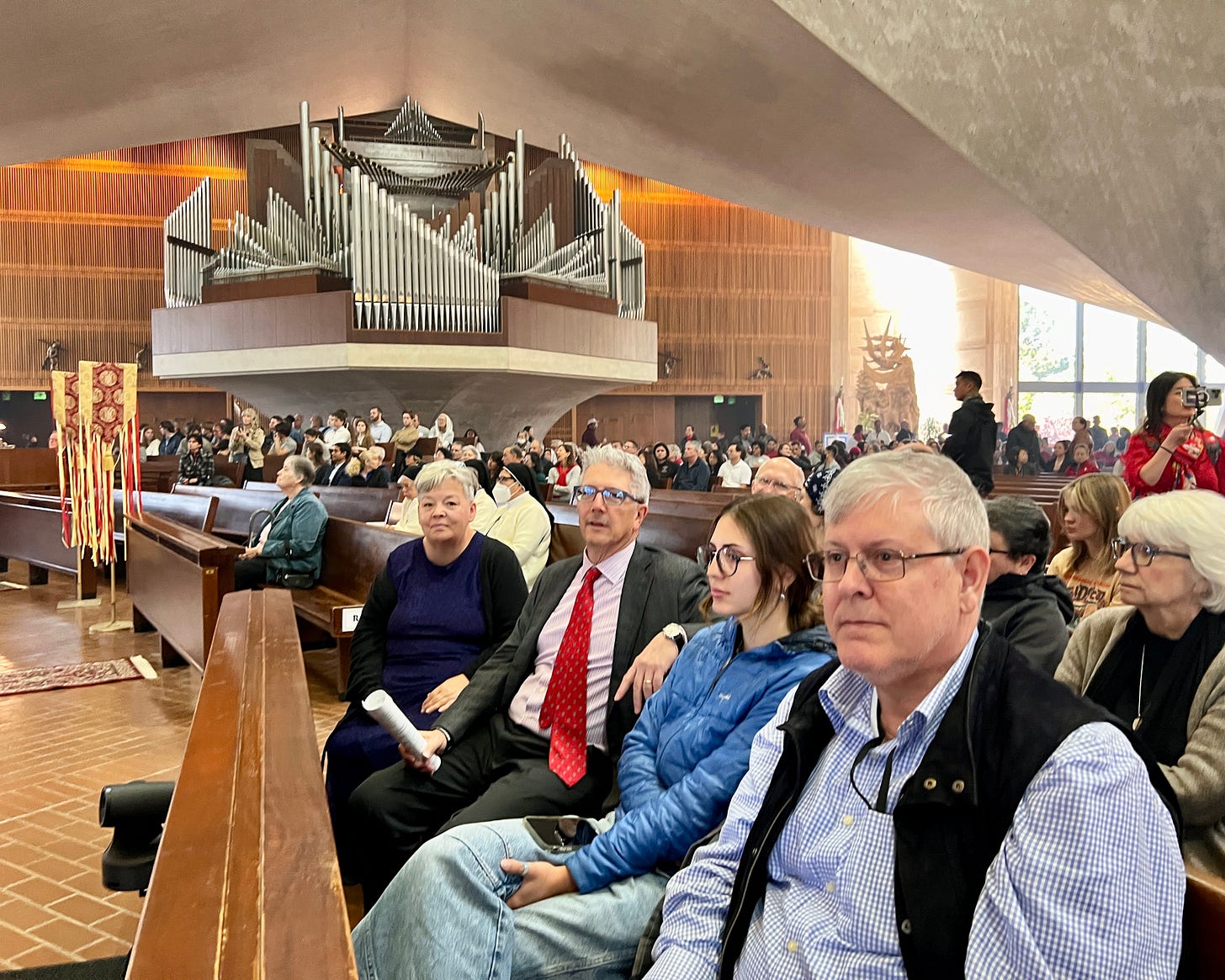
Afterward, I found Frank La Rocca in the church with his wife Lucia, took his picture, gave him a kiss on the cheek, and congratulated him on another triumph.
Here's a comment I found under the video that sums the Mass up very well:
"As Archbishop Cordileone said in his homily, we give our best to God. This holy Mass was the best…from the music, the flowers, the incense, the candles, the perfect rubrics on the altar throughout the Mass, the attentiveness and full participation of the approximate 2500 faithful in the pews to the beautiful voices of the babies making their needs known!! Come Holy Spirit! Give us the gifts you poured out on Pentecost so the Church can influence the world again as the Apostles did after Pentecost!"
The Mass was televised on the Cathedrals Across America series on EWTN. You can watch it here:



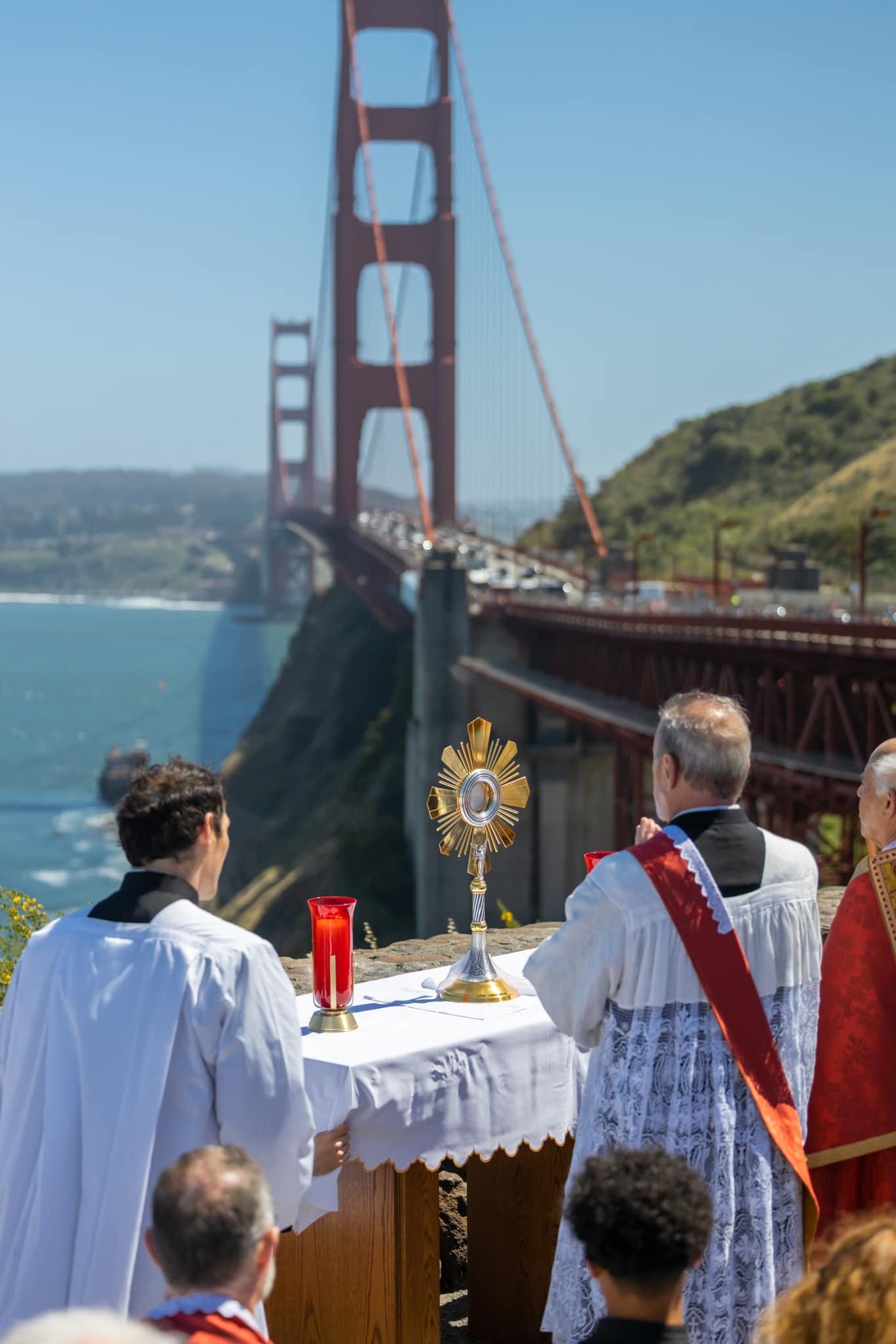
Epilogue
I'm not able to walk far enough to manage the procession over the bridge, so I met up with two other friends after most of the massgoers had left, and we stayed around for one of the high-class concerts that are scheduled almost every Sunday afternoon at 4 p.m. at the cathedral programmed by Christopher Tietze, Music Director/Organist. You should check those concerts out; they are much under-attended considering the quality of the music and the merely $10 suggested donation! A great way to spend part of a Sunday afternoon in San Francisco.
From "Cathedral’s multi-faceted choir program" about the series:
“'The flagship of the music program is the organ,' said Tietze of the Italian-made Fratelli Ruffatti organ. It has been acclaimed as one of the finest in the world.
“'It is certainly one of the most photographed instruments in the country,' he said.
"With 5,042 pipes, 66 stops and 92 ranks — organ-speak for its incredible musical capacity — the organ was built in 1971. A five-year renovation project on the instrument was just completed, according to Tietze, including the addition of some new pipes."
Images: Folias Duo, Flute and Guitar, at the May 19 concert and the cathedral’s Fratelli Ruffati organ. Photos by Roseanne T. Sullivan.
As we were leaving, we ran into a group of people who had joined the bridge procession and had bussed back. One woman in her thirties sat wearily in one of the nice chairs in the lounge outside the women's bathroom in the cathedral basement, and she told me the walk was great. She heard there were about three thousand in the procession. They celebrated Benediction on the other side, at the vista point. None of the cars or people going by had confronted them in any way. The wind was bad though. It was buffeting them so badly she was afraid to get anywhere near the railing, in fear of getting blown off. Her only other complaint was her two-year-old kept wanting to be carried. She was nursing her sore left arm. He crawled onto her lap while we were talking, and I was impressed. "He's a big one!" I remembered how my daughter had kept wanting to be carried at that age. We smilingly agreed she could offer it up for the cause.
Near the elevator, I ran into a couple I hadn't seen for a while, David Dittmann, who restored the tabernacle shown earlier in this piece, and his wife Regina. They walk a lot and are quite fit for their ages of 69 and 70, and they were flushed and happy. To show their support again for the Eucharistic Procession and Revival, they will be driving to Indianapolis in July to meet up with the pilgrims on the Serra Route and walk the final miles with them.
Ariel Solórzano told me he walked just behind Archbishop Cordileone’s lef shoulder all the way across the Golden Gate Bridge, and he saw the archbishop's face reflected in the monstrance. I told Ariel that I thought the archbishop's arms must have been painfully tired holding up the monstrance for all that long walk. He said that the archbishop had worn a specially ordered belt to help distribute the weight of the monstrance and make it possible to carry it such a long distance.
The next day I heard a story from one of the Benedict XVI Institute team members at our Monday meeting. His non-Catholic aunt saw the Eucharistic Procession as she happened to be driving across the bridge. "I knew that they must be Catholic because the men were wearing their robes. . . . So many protests on that bridge . . . . But this one was peaceful and loving. I could feel the peace." He added that's a pretty impressive thing for a Buddhist to say.
Afterward, Archbishop Cordileone had told Maggie that as far as he knows, there has never been a procession like that across the Golden Gate Bridge. It was a new kind of Happening for San Francisco.
May there be many more of this kind of sacred happening. And may the knowledge of God's gift of Love to us in the Eucharist be carried into previously unvisited places and hearts all over this land.
June 25, 2024: Today’s progress along the four routes (you can follow the progress here):




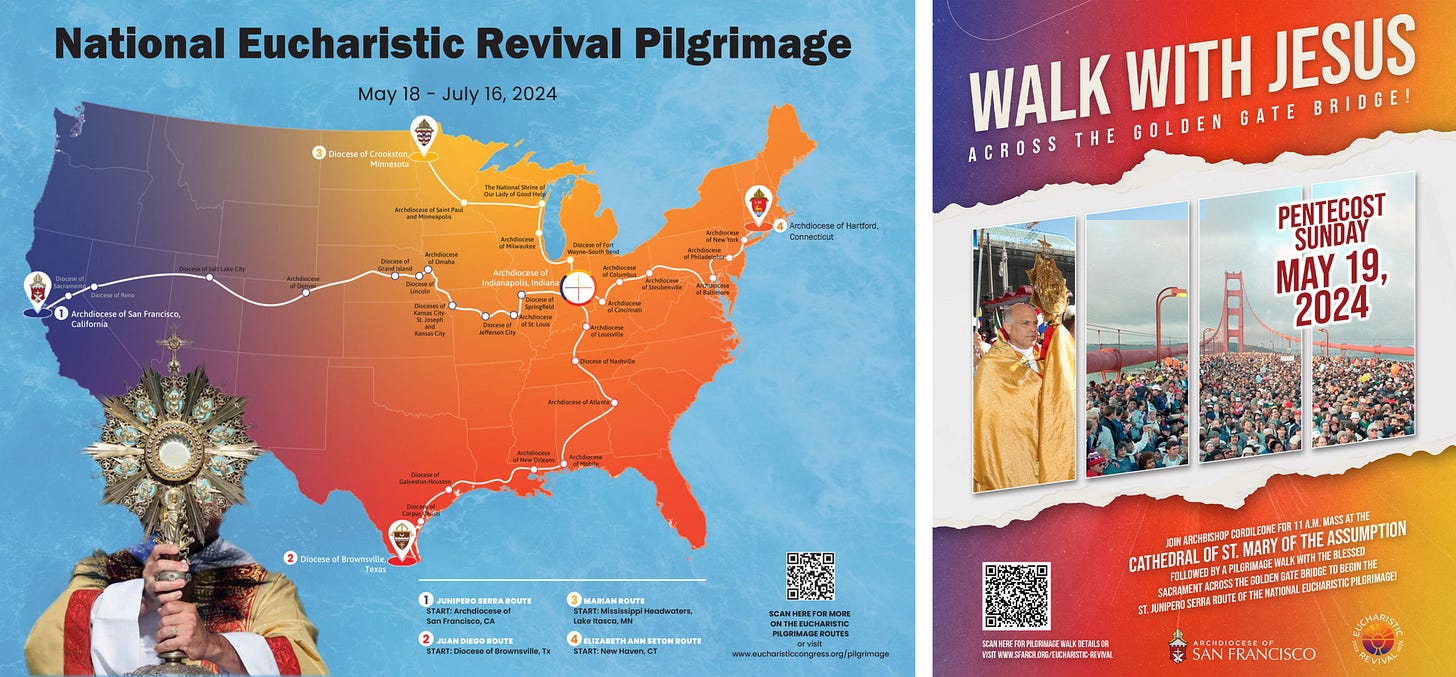

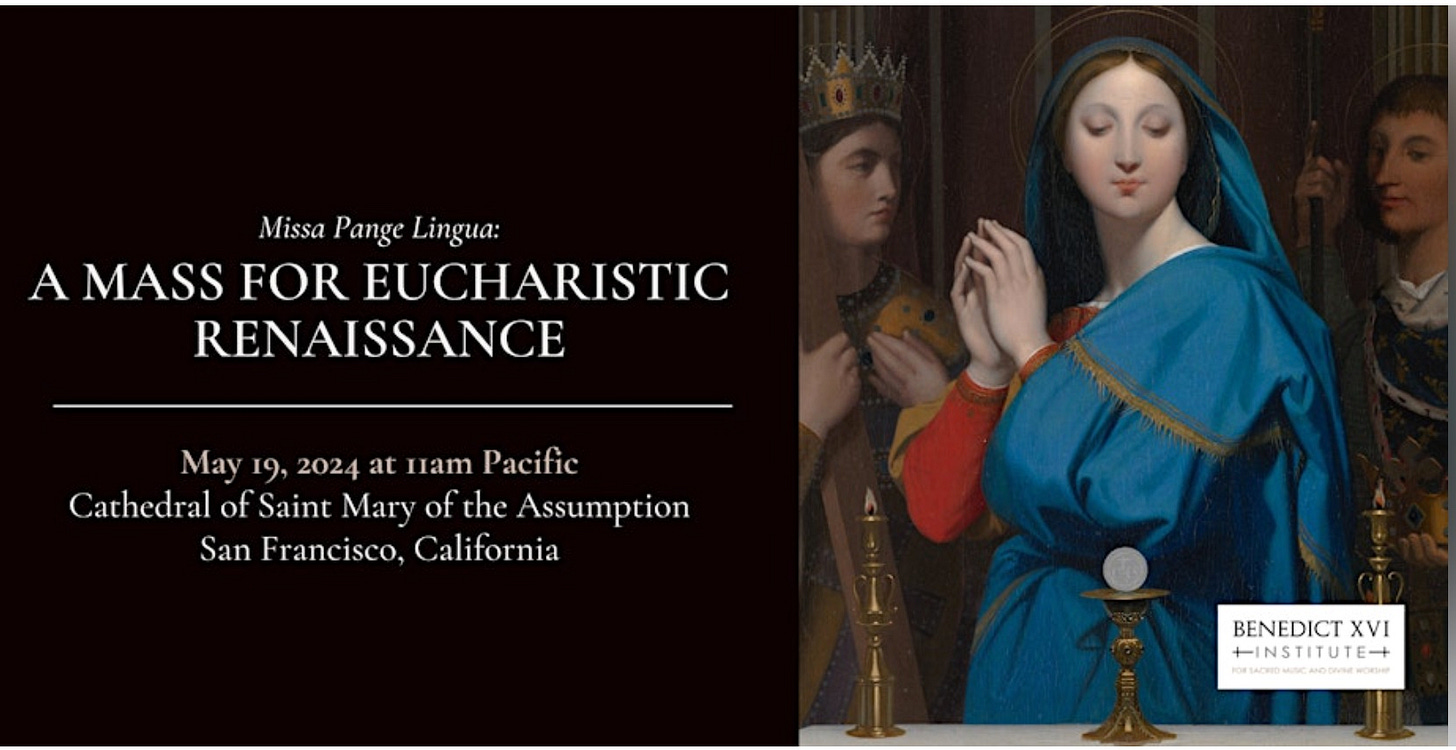


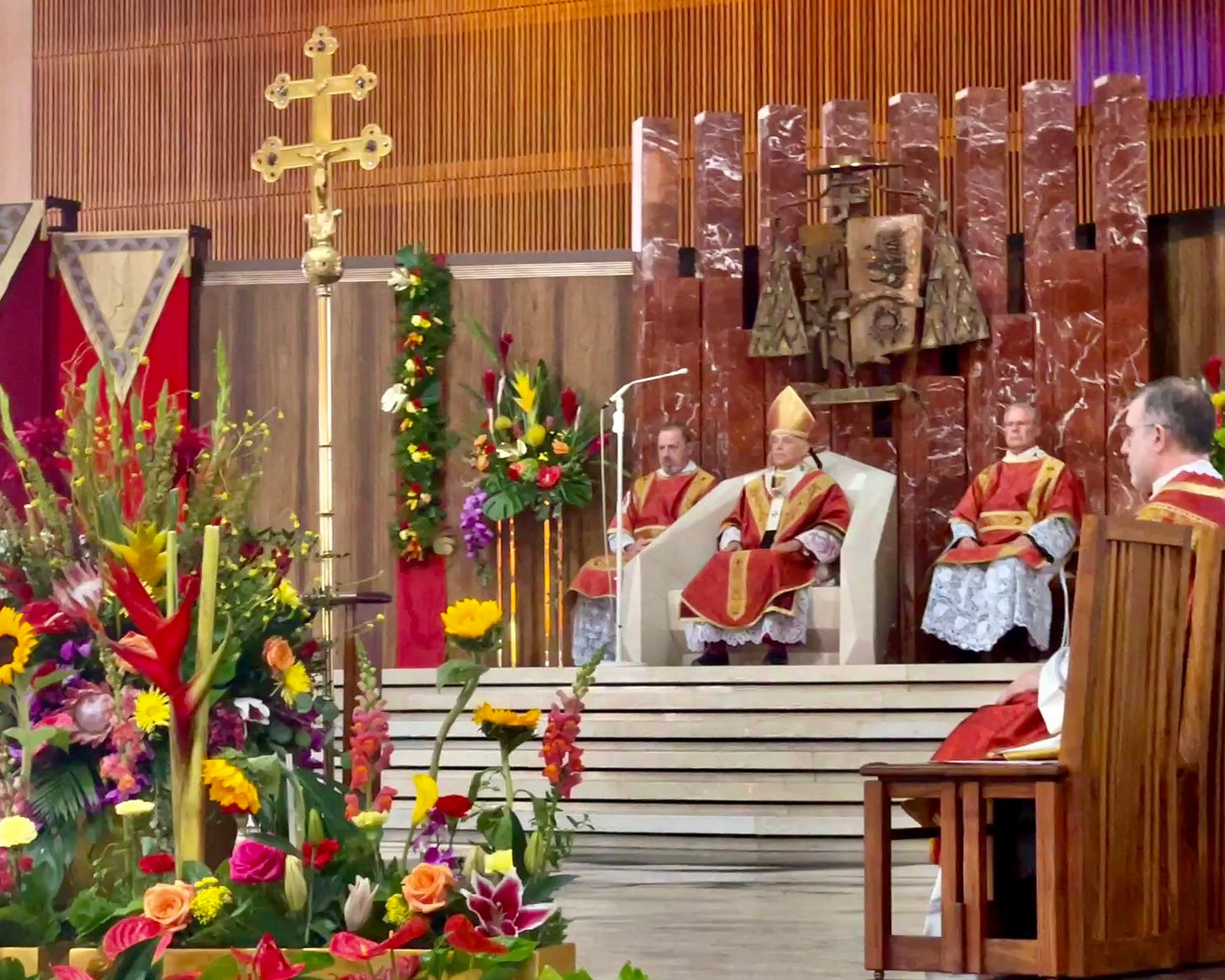



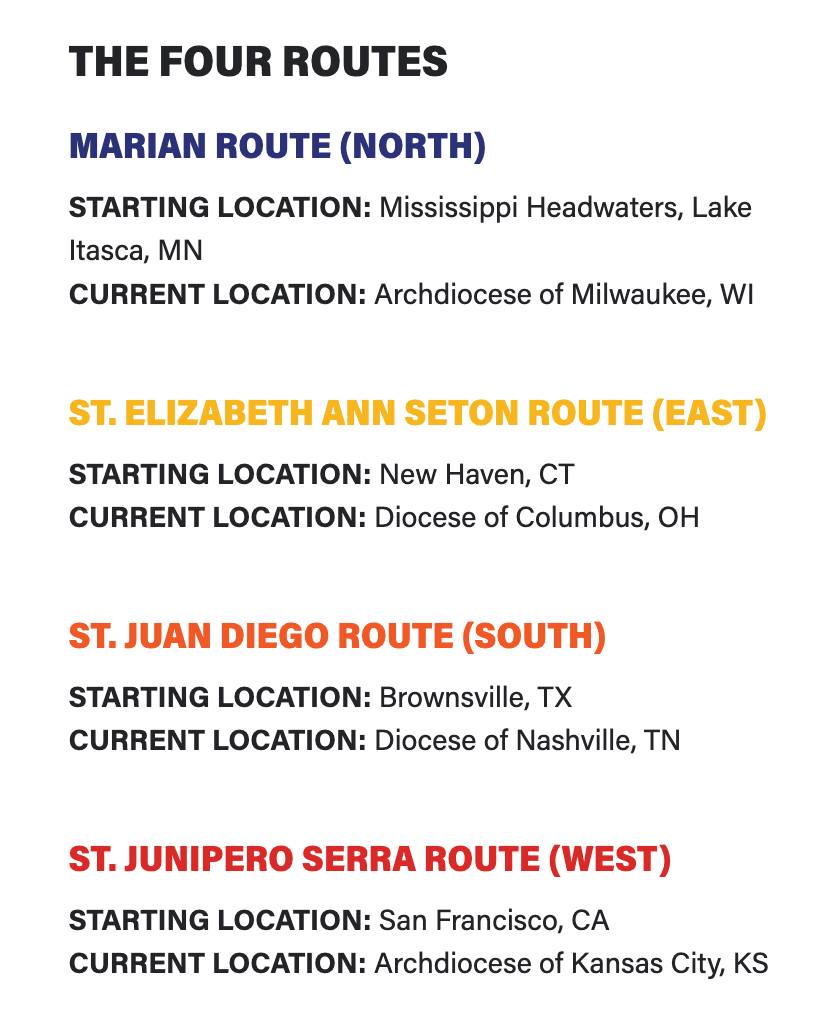
From email from Frank La Rocca: This was excellent: educational, engaging, comprehensive and genial. Thank you for the attention paid to the music at the Mass and for the lovely photo (and the kiss on the cheek).
God bless you, Roseanne.
From another email: "Dear Roseanne, Ty for Sharing these stories & pics...GOD Bless You!! 🙂🙏📿⛪️👑✝️🪔☮️⚖️🌎👼🕊❤️🤍💙🇺🇸🎆🎇🎆"
I need an emoji translator app1